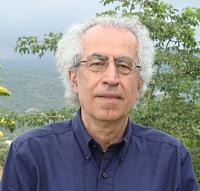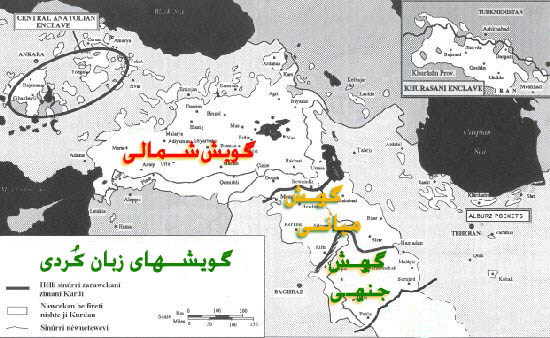Why the Genealogy Language Tree presented at KAL website shows some shortcoming as my home dialect of Pahli/Fayli shares great deal of vocabulary with Kelurri rather than Laki?
Why the Genealogy Language Tree presented at KAL website shows some shortcoming as my home dialect of Pahli/Fayli shares great deal of vocabulary with Kelurri rather than Laki?
Why the Genealogy Language Tree presented at KAL website shows some shortcoming as my home dialect of Pahli/Fayli shares great deal of vocabulary with Kelurri rather than Laki?
Sun, 27/07/2008 – 08:40 — Admin
Similarity in vocabulary is the tool of the non-trained linguists looking to find “connection” between languages and/or dialects of the same language. This is a mistaken path to take.
As an example, 60-65% of English vocabulary is French in its root, going back to the time of the Normas. Despite this, English is a Germanic language not a Romance language (like French), because it is the grammar and the structure that determine the affinity of tongues not vocabulary. Likewise, Azeri and Turkish overflow with Persian words (or Arabic words that come through Persian). And yet, Azeri and Turkish are Altaic languages not Indo-European like Persian is. The fact that nearly half the literary Persian words are also Arabic in their origins has never reclassified Persian as a Semitic language (like Arabic). Vocabulary should almost never be used to determine affinity between languages and dialects, as it can be very misleading.
So, what if this dialect or that dialect of Kurdish contains a lot of similarities to another dialect? Again, it is the grammar and the structure that needs to be examined. Such examination, however, is the domain of a trained linguist, who has gone through systematic training, done many field works and has collect data to determine the exact connection (or the lack thereof). The sources available to us today show that the Pahli/Fayli and Silakhuri are of the same Laki dialect group, and are bridged together by the subdialect of Biranawandi. One needs to know the grammar and the structure of Biranawandi subdialect (spoken in Harsin, Nurabad and Sahna, as well as the neighbouring areas) in order to realise the connection between Silakhuri of Lakistan and Fayli of Pahla.




Comments
Tue, 01/06/2010 – 05:58 — LekiKurdish
Some Historical notes about the word of “Lek”!
http://lak-kurd.blogfa.com/post-31.aspx
Sun, 10/08/2008 – 17:21 — DRoshani
Nazdar Sewan, Ewe ki le lay ….
Nazdar Sewan, Ewe ki le lay min giran e, nazdarí (réz) zuwan Kurdí we her shíwe wetin ya nùsíníye. Le lay min wer le her cishtíg mirov (ayem) bayes gewrayí zuwanegey le wekar hawirdiní díyar biked. Kak Sewan, tu le xuwed rewa zaníd le ser babetíg leywa giran wír xuwed péshkesh bikey, bes rewa níyezaníd cù babetege núsíd, wete hellgiríd, yan bùshey (lehje) xuwed pasewaní bikey.
Ye bari serkí le ser shani her ùsheríge (qiseker) ki we húshyarí zuwani nùsíní wekar búd ta samani zuwan Kurdí we gishtí pirrtir biked. Her wew júre ki xuwed ùshíd, ey babete bayes erray xawin wír ú usakar bimínid. Mirov júri xuwed bayes we dillgermí her des we qellam bún ú binùsin. Wey júre ferhengi nùsín we shíwe bùsheyli xuwar samandartir biken. Íse giraní bùshe Kurdíyegan le genjíney ùshey nùsanini ímrújhíyan díryar búd. Bíla íme ser xuweman weli ey nawe, ew leqe we jhan narím ú hani xuweman we bani nùsín bineym.
Bùshey Kurdí xuwar bayes berhemi nùsíni xuwey fire ú firetir biked. Tenya wey shíwe karayí ú hawsaní xuwey derxed. Tu níyexuwazít her we nawíg jí bùsheyg díyar bikey. Jí bùshege we berhemeganí/nùsíneganí díyar kiryed. Weli túzí renj ú kúshish mirov júri xuwed tùwenid húkarey nùsíni Kurdí búd, ú heftey yek berhemi nùsíní we babeyli jíya jíya búd. Cen kes nasíd ki le nawcegani xuwar Kurdistan babetíg le ser zanisti bazerganí (ki kari xuwede) binùsin? Eye dewri zanistí xuwede ú grantir we her cishtíg tùwenid yarí zuwannas ú mínewan erra besh kirdini zuwani Kurdí bíyey.
Fire memnún Dr Dílan Roshaní
§——————————————-
– Alfabéygí Yekgirig/Yekgirtú careseri bineyíg erra girifteyli zuwani Kurdí ye!
– “We must become the change we want to see” [quote: Mahatma Gandhi]
Fri, 08/08/2008 – 18:36 — Sewan
dobara slam: Me xwazm dobara
dobara slam:
Me xwazm dobara da era ya bwishem ka zarawey Feyli warde Laki fargh keig. Me hamisha e’teghadem awa bwiya ka zwane kurdi da 2 dastey kolli xarej nya: 1)Gorani 2)Kurmanji
Wa nazare me, zarawey Gorani twianig nawe Monasebeg bug aray kurdie bashuri,yane, ema twianim bwishim ka kalhorie kermashan,Faylie ilam,Laki u hatta hawrami da naw 1 gorooh wa nawe goroohe GORANI gharar begren.
Goroohe 2 ham goroohe zaraweyle kurmanji bug:yani kurmanji bakuri ka da naw kurdeyle turkia u shomale kurdistane iraq u qafqaz u kurdeyle xorasane iran we qsa kereg, wa kurmanjie bashuri ka hamo sorania.
Me aram baese ta’ajjoba ka kurdie kalhori da naw goroohe kurmanji gharar bem u kurdie Fayli ka kollan shayad ha 50 kalama warde kalhuri fargh bkeig da naw goroohe laki.(awa nazare aghaye professor izadia.)
wa har hal me xwazem awa bwishem ka wa nazare me zaraweyle kalhori,Feyli ,laki wa hawrami da naw yak gorooh gharar gren wa geshtyan da zhire nawe kurdie bashuri .albata wa nazare me,nawe GORANI xaas tarin nawiga ka twianim aray aw gorooha bnimen .
Me hichvaght niaxwazem wa onwane yek professional da era nazar bem, har,wa onwane kasig ka geshte aw zaraweyla da nzikaw ashnasig wa wardyan ashnast, nazare xwam matrah kam.
Wa har hal, che laki,che Feyli,che kalhori,geshtyan wa aghidey me da nawe yak gorooh gharar gren wa naw Bashuri ya agar ba shiwey xaas tr bwishem,GORANI.
Umidwarem ewa u geshte kaseyleg ka aray mellate kurd u zwane kurdi talash kan,hamisha sarbarz u tandorost bwen.
Sewan
Sat, 02/08/2008 – 17:35 — Admin
Grammar not vocabulary
Dear Sewan, It would have been a great idea if you could write a topic in at least 500 words where you use your home dialect and allow us to elaborate on the root and measures for dialectal differences. The science of Dialectology needs good skills in practical filed work as well as deep historical and sociolinguistics expertise.
You will not be able to make concussion on the bases of you example such as “Ce wetí?” as this short sentence is similar in all dialects sub-dialects of south Kurdish. Please take your time and write us a short text of 500 words in your home dialect.
The Verb of “Witin” in Lekí/Pehlí and “Wetin” in Kellurrí has the tense in simple past as
Lekí: Witim, Wití, Wit, Witím, Witíd, Witin (source: Ferhangi Lekí, Muhammad Izadpanah)
Kellurrí: Wetim, Wetí, Wet, Wetím, Wetín, Wetin (Source: Destúr zebani Kurdí Kelhur, Karim Karimpúr)
So the way each one of the speakers of these subdialects would say to some listener directly would be
Lekí: Ce wití?
Kellurrí: Ce wetí?
As I said you will need a full text, and good dialectology skills to come to a solid realise the choices presented at our web site.
Tue, 25/05/2010 – 18:02 — LekiKurdish
Re:Grammar not vocabulary
Hi: I am a Lekí Kurdish speaking in Luristan providence. I just wanted to make some correctness here and give some more examples from Lekí grammer …
********************************************************
I…them
Mi/Tu/Iw/Íme/Hume/Iwin
Here/There/It/That/These/Those
Ére/Úire/Ye/Owe/Yiwine/Owine
Possessive Pronouns.
My sister:
Xuem/xuet/xué/xuemon/Xueton/Xuewon
(-em/-et/-é/-emon/-eton/-ewon)
“He got his book from them and came back to home”…”Iw kitaúe ejh owin sené w gil aúirdé era mall”
myself…themselves
úijhim/úijhit/úijhé/úijhmon/úijhton/úijhon
To go: Cén
I go:
Lekí: mecim/ mecín/ mecú/ mecímin/ mecínon/ Mecin
(-im, -ín, -i(-ú), -ímin, -ínon, -in)
I came:
Lekí: hetim/ hetín/ het/ hetímin/ hetínon/ Hetin
I am Kurd:
Lekí: mi Kurdim/ tu Kurdín/ iw Kurde/ íme Kurdímin/ hume Kurínon/ iwin Kurdin)
I am from Kurdistan:
Lekí: me ejh Kurdistanim/ tu ejh Kurdistanín/ iw ejh Kurdistane/ íme ejh Kurdistanímin/ hume ejh Kurdistanínon/ iwin ejh Kurdistanin)
I said:
Lekí: vitim/ vitit/ vité/ vitmon/ vitton/ viton
What did I say?
Lekí: Cem vit? /Cet vit?/ Ce vité?/ Cemon Vit?/ Ceton vit?/ Ceúon vit?
Where did I go?
Lekí: Kú cim? /Kú cín?/ Ku cé?/ Kú Címin?/ Kú cínon?/ Kú cin? (where did I…they go ?)
Cheers
Tue, 29/07/2008 – 22:55 — Sewan
some notices
I have to say this idea is completely un acceptable for me to concider Fayli as a sub dialect of Laki and suppouse laki as an independent dialect.
While Laki is not an independant dialect like sorani to say : ardalani sorani or babani sorani ,laki is laki and it is a sub dialect . as it can not be a sub dialect of sorani or kurmanji, and as there is one more independant dialect and that is Gorani so i believe, Laki as well as Feyli and kalhuri are sub dialects of Gorani.
It is so weired to think kalhuri is a sub group of Kurmanji!!! as i once read it somewhere.
Im not a professional but as i have realised in 24 years of my life is, there is no any difference between kalhuri and Feyli ,and if there is, it wont be more than maximum 50 words.
About laki i can say, i is more different from these two and grammatically it follows sorani in few senses .
As an exampl i can say : in kalhuri and Feyli it is said: cha wati?
while in laki is said: chat wet? or Cha kerdy?in Feyli and kalhuri and Chat kerd? in laki (same with sorani)
so,I believe your article has some weaknesses that shuold be recorrected.